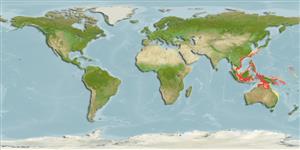>
Kurtiformes (Nurseryfishes, cardinalfishes.) >
Apogonidae (Cardinalfishes) > Apogoninae
Etymology: More on authors: Smith & Radcliffe.
Environment: milieu / climate zone / depth range / distribution range
Ecología
marino asociado a arrecife; rango de profundidad 25 - 82 m (Ref. 11356). Tropical
Western Central Pacific: Papua New Guinea (Ref. 11890) and the Philippines (Ref. 280).
Tamaño / Peso / Age
Maturity: Lm ? range ? - ? cm
Max length : 7.0 cm TL macho / no sexado; (Ref. 126023); peso máximo publicado: 5.14 g (Ref. 126023)
Found in lagoon reefs.
Life cycle and mating behavior
Maturities | Reproducción | Spawnings | Egg(s) | Fecundities | Larva
Mouthbrooders (Ref. 240). Distinct pairing during courtship and spawning (Ref. 205).
Allen, G.R., 1993. Cardinalfishes (Apogonidae) of Madang Province, Papua New Guinea, with descriptions of three new species. Rev. Fr. Aquariol. 20(1):9-20. (Ref. 11890)
IUCN Red List Status (Ref. 130435)
Threat to humans
Harmless
Human uses
Herramientas
Special reports
Download XML
Fuentes de Internet
Estimates based on models
Preferred temperature (Ref.
123201): 24.8 - 28.3, mean 27.4 °C (based on 157 cells).
Phylogenetic diversity index (Ref.
82804): PD
50 = 0.5000 [Uniqueness, from 0.5 = low to 2.0 = high].
Bayesian length-weight: a=0.01122 (0.00528 - 0.02384), b=3.10 (2.92 - 3.28), in cm total length, based on LWR estimates for this (Sub)family-body shape (Ref.
93245).
Nivel trófico (Ref.
69278): 3.4 ±0.5 se; based on size and trophs of closest relatives
Resiliencia (Ref.
120179): Alto, población duplicada en un tiempo mínimo inferior a 15 meses (Preliminary K or Fecundity.).
Fishing Vulnerability (Ref.
59153): Low vulnerability (10 of 100).
